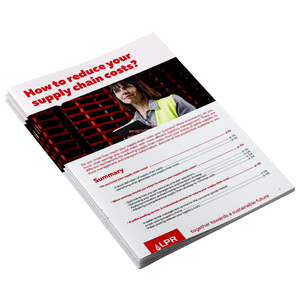How much does your supply chain cost? If you don't know the answer, it's a safe to say that your company's logistics costs are probably too high.
The supply chain is made up of several elements (production of raw materials, supply, manufacturing, storage, transport, distribution) which each generate various costs.
Seeking efficiency savings at every stage of the chain is vital to maximising a company's profitability. To do this, you should know your logistics costs inside out in order to reduce them.
The challenge for people in charge of managing all or part of the supply chain is to streamline processes and save money wherever possible... without losing quality!
In this article, we will identify the different logistics costs of a distribution chain, measure them and then demonstrate how to reduce them.
Quick Navigation:
1 - What are the logistics costs of a company?
2 - What are the causes of high logistics costs?
3 - How to measure the logistics costs of a company?
4 - How to reduce the logistics costs of a company?
1. What are the logistics costs of a company?
Logistics costs are all the costs generated by the supply chain, from the production of raw materials, to the consumption of the product by customers.
These costs are often divided into two broad categories:
-
Operational logistics costs: these are costs related to facilities like warehouses or distribution centres.
-
Transport costs: these are costs related to the movement of goods. For the majority of companies these costs are the major component of logistics costs. The flow of goods must therefore be subject to special attention!
This division of logistics costs into two distinct families doesn’t necessarily take everything into account. To really get to know the expenses generated by your supply chain, it is relevant to identify them step-by-step.
1.1. Storage costs
These include warehouse costs and which can be very varied.
These costs include the storage space itself has a cost which is notably impacted by:
-
leasing or spreading the cost of purchase.
-
warehouse insurance.
-
space taxes and levies.
As well as the cost to purchase the infrastructure and equipment necessary outright for the operation of the warehouse. They also represent a major capital asset for a company. These include:
-
handling machinery: forklifts, pallet trucks, etc.;
-
shelving.
-
warehouse management software (which may have a substantial cost).
Having the correct size storage space is therefore essential for the sustainability of your company.
Without sufficient resources, the warehouse will operate slowly and chronic delays and longer delivery times are to be expected.
Conversely, an excessive allocation of resources will tie up capital.
1.2. Transport costs
These costs are related to supplies, distribution of products and the wider movement of goods in general.
Delivery time is the main factor determining the cost of transport: the shorter it is, the higher the price.
You must find the right balance between time and delivery costs to rationalise your transport costs. Reducing transport costs often involves anticipating deliveries and for this, it is essential to adopt a method of managing stock and supplies that gives you sufficient foresight.
1.3. Supply costs
These costs relate to the purchase of the raw materials necessary for the manufacture of the products. They tend to be managed by the purchasing department.
Negotiating with suppliers has a strong impact on this part of supply chain costs.
1.4. Maintenance costs
As mentioned above, a supply chain relies on a multitude of infrastructures and various pieces of equipment.
The failure of just one of them can quickly cause problems. From a fall in quality in the service offered to the customer, a delay in delivery, or even a complete failure of the entire supply chain!
To avoid this, the maintenance of your equipment is vital. However, this comes at a cost.
Monitoring and planning software are necessary to carry out preventive maintenance, which can be expensive.
In addition, the service providers and/or staff performing this service also represent an expense.
1.5. Inventory costs
Good warehouse management begins with an accurate stock balance. Without this, you expose yourself to discrepancies and stock shortages that are harmful to the profitability of the company.
To identify the quantities of each of your products, inventory management software is a useful addition. It allows you to view your stocks on dashboards and anticipate restocking.
It is also important to carry out regular physical stock checks to compare reality with theoretical balances.
The tools used and the personnel required to carry out the work represent a logistical cost that needs to be taken into account.
1.6. Order Picking costs
In the supply chain, the preparation of orders is a determining factor in its overall performance. If it is not streamlined, it can cause delays throughout the entire chain.
Order preparation also entails costs: personnel, handling tools, packaging, consumables, electricity… All of this has a price that can be optimised.
2. What are the causes of high logistics costs?
The sources of logistics costs are far reaching, and are often higher than necessary for a number of reasons.
2.1. Hidden costs in the supply chain
There are both visible costs and hidden costs that impact upon the profitability of the supply chain.
Visible costs are easily identifiable since they correspond to an obvious company expense: delivery by haulier, for example.
Hidden costs can be more difficult to identify. These costs can be caused by:
-
lost stock: this is a real challenge for companies that sell products with use-by dates, particularly in the agri-food sector. Lost stock is a stock of products whose expiry date has passed and can no longer be sold. It represents a net loss for the company, since its purchase, transport and storage are not compensated.
-
stock shortage: this does not cost the company money directly. However, it will cause delays in deliveries to the customer and cause dissatisfaction. Customers may choose to turn to competitors as a result.
-
overstocking: this involves storing more products than necessary, leading to higher storage costs and space that cannot be used by other products.
To avoid these hidden costs, you should optimise your inventory management and anticipate product demands ahead of time.
2.2. What causes high logistics costs?
High costs can be driven by many factors in the supply chain, including:
-
Poor design of the delivery system: if routes are not optimised, delivery times and/or costs can be unnecessarily high.
-
Low staff productivity: if the operators are not managed correctly, their productivity may not be optimal. In this case, it is time to rethink team management.
-
Inefficient use of transport: packaging, pallets, trucks… for example, if the containers you use to move your products are not sufficiently packed, your logistics costs will not be maximised.
-
A poor order preparation procedure: unnecessary round trips, lack of consumables, unavailability of goods... if your orders take too long to be prepared, the profitability of the supply chain will not be optimal.
-
Unsuitable storage: as stated above, storage space has a cost that can be significant. It must therefore be perfectly optimised! If your stock is not suitable for your storage location, space will be underutilised. In this case, you need to rethink your warehouse setup.
3. How to measure the logistics costs of a company?
Using logistics indicators allows you to measure the performance of your supply chain and clarify your objectives. These indicators are essential for evaluating the cost of each element, and for identifying the steps to be used to reduce them.

3.1. Supply logistics indicators
It is necessary to measure the ability of your suppliers to satisfy the orders that they receive. If they are unable to fulfil the orders being received, it will be necessary to source new suppliers.
To calculate this, we can use the compliance rate of supplier orders which is calculated as follows:
(Number of refused orders / Number of fulfilled orders) x 100
The lower the number, the better your supplier.
The logistics service rate is also a good indicator. It indicates the number of orders received on time.
For example, for an order of 100 products placed, if 70 are delivered on time, the service rate is 70% for this order.
A late order equals a service rate of 0%.
The reliability of your suppliers is an essential factor in optimising your logistics costs. If they fail to fulfill the orders you place, your inventory management will take longer and therefore be more costly.
In addition, a failing supply jeopardises the rest of your supply chain and you risk losing increasingly dissatisfied customers!
3.2. Storage logistics indicators
Optimising your storage space is essential to maximise profitability.
To measure the efficiency of your warehouse, you can use several logistics indicators such as:
-
the storage unit cost
-
the cost per square meter of the storage facility
-
the warehouse occupancy rate
-
the availability rate (rate of products available to the customer)
Stock life is also an indicator you can use to measure the effectiveness of your stock. This is the number of days it takes for a stock of products to be completely sold out.
The lower it is, the more effective your management is!
3.3. Inventory logistics indicators
A reliable inventory means optimised inventory management and a more profitable supply chain.
To measure the accuracy of your inventories and the reliability of your inventory tracking tools, the markdown rate is a relevant metric.
It measures the difference between the theoretical stock and the actual stock (items missing or stolen). The greater the missing stock, the more important it is to carry out regular inventories and put in place measures to avoid product disappearances.
3.4. Transport performance logistics indicators
As the first cost item for most supply chains, transport efficiency must be measured to eliminate waste.
The on-time delivery rate, or DOT (Delivery on Time), allows you to measure the efficiency of the means of transport you use. It is particularly important if you use an external service provider to ensure deliveries to your customers.
The fleet utilisation rate is also a good indicator of the degree of optimisation of the vehicles used. It measures the difference between the volume available and the volume used (or the load, depending on the pricing to which you are subject).
If your trucks are not full, your transport plan is not efficient.
4. How to reduce the logistics costs of a company?
4.1. Make economies of scale
The larger the quantities, the lower the unit cost. Try to achieve economies of scale wherever possible in your supply chain to rationalise your costs. For example :
-
Deliver less often but in larger quantities to your customers
-
Use larger trucks to transport more cargo in one trip
-
Set up vertical storage means to make every m² of your warehouse more profitable
-
Place larger orders with your suppliers to lower the unit cost of delivering raw materials
4.2. Optimise packaging, storage and vehicles
Empty space is not free!
Boxes, pallets and vans filled to 50%, still cost 100%.
Optimise your storage, order preparation and delivery procedures to use all available space.
Within warehouses, use standardised storage spaces designed for general-standard pallets.
At LPR- La Palette Rouge, we provide our customers with transport and storage pallets designed to be used in a number of storage configurations and to be used in automated systems.
Optimising your packaging and stock also involves looking for multiple uses. For example, a display pallet makes it possible both to transport your goods and to deploy them quickly at the point of sale.
4.3. Use cross-docking
Cross-docking is a term commonly used in supply chain vocabulary. This practice consists of centralising purchases in a distribution center.
Rather than managing the deliveries of each of your suppliers, you only have to manage a single trip.
This method can also be used to transport your products directly to your customers!
4.4. Change haulier
Changing haulier can save you money. Compare the different hauliers you can use and negotiate with them to get the best rates.
When making your comparison, it is important to make sure that you understand the ‘whole cost’ to your business. This includes the delivered cost, but should also include deadlines, reliability and routes.
LPR - La Palette Rouge has an extensive and very dense network of more than 28,000 collection points and 134 service centres throughout Europe. It is this network that allows us to offer efficient transport solutions to the companies that trust us, all over Europe.
4.5. Change your inventory management system
A supply chain without an inventory management system is working blind.
If you experience late deliveries or stock shortages frequently, you may need to rethink the method used to manage your stocks and supplies.
Choosing a solution adapted to your challenges will allow you to make significant savings.
To learn more, discover our article on the different methods of inventory and supply management!
4.6. Digitise the supply chain
Today, the use of IT solutions has become almost essential in the supply chain. Management software is a real help when you’re searching for performance gains and optimising the supply chain.
Analysis, monitoring, forecasts, visualisation, dashboards… are all made possible by new technologies and Big Data.
If you haven’t done so yet, you should consider implementing a management system such as a TMS (Transport Management System) or a WMS (Warehouse Management System) to streamline your supply chain costs.
4.7. Use Green Supply Chain Management
Green Supply Chain Management aims to reduce ecological impact.
The reduction of the environmental impact of the supply chain starts with simple steps (i.e. turning off the lights in the warehouse when no one is there using to presence detectors) and ends at the more ambitious (i.e. setting up a product repair and recycling service).
In addition to having a beneficial impact on the planet, GSCM (Green Supply Chain Management) improves the company's image and sales, and also reduces costs!
In fact, reducing a company's carbon footprint often also involves reducing energy expenditure. Stationery supplier Staples managed to reduce fuel consumption by $2.5 million per year by modifying its delivery system.
Using more ecological logistics management ultimately saves you money.
If you would like to discuss your logistics issues with our business experts, you can contact them here. You can also access our other blog articles to learn more about pallet pooling.


